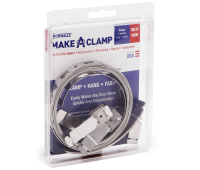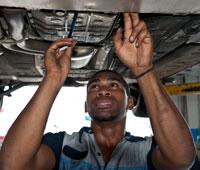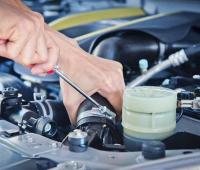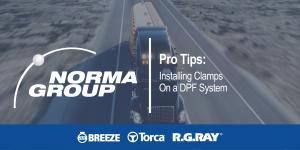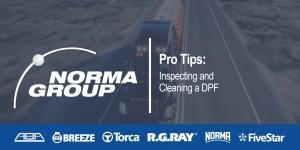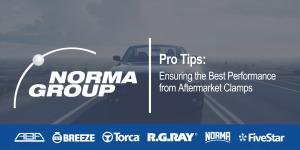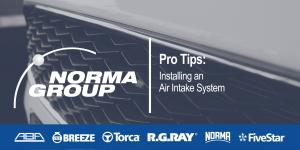Pro Tips
Are you a mechanic or repair technician in one of the many industries we serve? In need of some quick repair tips on a particular job?
As the global leader in engineered joining technology in the original equipment industry and aftermarket, you'll find everything you need right here, including troubleshooting tips, installation videos and in-depth product specifications, how-to articles, frequently asked questions and more. You’ll also be able to search on hot industry topics in our frequently asked questions section, and reference articles written by certified mechanics with decades of experience – that address the most pertinent repair jobs today.
Articles
Product Quality Repair / How-ToTroubleshooting
see allReplacing an old clamp with a new clamp that is too wide for the channel will not only crush the beads on the outside of the channel, it will result in a poor seal. In an automotive situation, this air leak can cause a ‘check engine’ light to come on.
Many molded hoses have a special channel for the hose clamp. These channels are typically found on air intake systems in cars, trucks and many powersports applications. Attempting to replace an old clamp with a new clamp that is too wide for the channel will not only crush the beads on the outside of the channel, it will result in a poor seal.
DPF service intervals that occur much more often than every 100-200,000 miles could likely be due to leaks in the intake system or exhaust system, located upstream of the DPF. For more information on this topic, read our article on Testing for Leaks in Aftertreatment System.
Spring-loaded constant tension clamps like the NORMA FBS style can be difficult to remove and replace without the proper tools. NORMA sells two styles of specialty pliers for removal and installation of these clamps. See the NORMA catalog for details. The Cobra style bolt-free clamp requires the CHT1 tool for proper installation.
Failed Exhaust Clamp. There are two scenarios that are most likely when you hear ringing under the car when the engine is running:
First, your U-Bolt clamp may have rusted and given way, potentially causing an exhaust leak and at the very least, an annoying ringing noise. This is definitely a situation where the clamp’s quality comes into play.
The second failure comes from mechanics or DIYers who re-use clamps that have already been in service. When the clamp is properly tightened, the U-Bolt is stretched slightly beyond its original shape. This ensures that it stays tight for the life of the exhaust system. When re-using a clamp that has been previously stretched, the metal weakens significantly and increases the chances of breakage during operation.
There are a few reasons that you may be experiencing a leaky hose after a new clamp install:
The hose is not properly compressed. A hose that has been previously clamped will have a witness mark or groove on it from the original clamp. When you install a new clamp on a used hose, it will not compress the hose properly due to indentations on the hose from the original clamp – usually resulting in a leak.
You may have selected the wrong type of replacement clamp. Attempting to replace an old clamp with a new clamp that is too wide for the channel will not only crush the beads on the outside of the channel, it will result in a poor seal.
For example, you should never replace a constant tension clamp with a worm drive hose clamp. Constant tension hose clamps come in many varieties, with one thing in common: they are designed to keep constant pressure on the hose in temperature extremes. Replacing a CT clamp with a WDHC is just asking for a leak or breakdown.
Improper placement of the clamp on the hose. Rubber hoses that fit onto a connection with a bead require the clamp to be in the right place. The clamp should be right up against the bead on the connection, however not on it. If the clamp is placed farther back, it creates a small crevice behind the bead. The chemicals in the coolant will deposit in this crevice and begin to corrode the metal connection. They will actually erode metal and the next time a hose is replaced, it will not seal due to corrosion forming or “crevice attack.”
Overtightening the clamp. Many failures and leaks are caused by overtightening the clamp. This can even cause complete clamp failure during the initial installation. While we realize that most people will not use a torque wrench when installing clamps, please refer to the torque specs we recommend, based on the type of clamp.
You installed it on a used hose. When you install a new clamp on a used hose, it will not compress the hose properly due to indentations on the hose from the original clamp. This usually results in a leak because the hose is not properly compressed. Always replace rubber hoses and clamps together for the best job and to reduce the potential of a comeback.
FAQs
see all Quality
Each clamp is engineered with a specific combination of metal to withstand the condition it’s used in but most NORMA clamps are made from high-quality stainless steel and galvanized steel to prevent corrosion and clamp failure.
NORMA offers more than 40,000 SKUs of engineered joining technology solutions to more than 10,000 customers around the globe. NORMA branded aftermarket clamps are used in a number of different industries and applications, from passenger and commercial vehicles to trains, ships, military vehicles and aircrafts. They are also used in commercial buildings, water management systems and in biotechnology.
NORMA Group boasts one of the world’s best-equipped laboratories, which conducts life cycle tests for all relevant applications, including water, fuel, exhaust, turbocharger and other air and gas applications. Its state-of-the-art test facilities support the development of new products and allow NORMA Group to test customer specifications. This includes testing for tensile strength, durability and corrosion resistance.
The temperature range ultimately depends on the clamp and the application it is being used on. We test all our products to ensure they can perform in real-world conditions and have lab equipment that simulates temperatures ranging from -104°F to 1742°F.
NORMA invests more than $30 million annually into product development, engineering and testing and spends more than 3,000 engineering hours on every product to design, develop and test it to ensure it meets OEM specifications. These clamps have been tested for performance and corrosion resistance in extreme conditions and are made from higher quality material for optimum performance. Some aftermarket clamps are made from inferior metal and aren’t tested to the same standards as NORMA Group.
It’s important to use clamps from a trusted source. NORMA’s clamps are manufactured from premium steel stock and made to exacting specifications for the same or better performance as their original equipment clamps. Many offshore-made aftermarket clamps are made from inferior steel and do not have the same durability and corrosion resistance as clamps made by reputable suppliers like NORMA.
Maintenance
Place the clamp just behind the hose bead and then tighten until the hose is slightly compressed. General specifications for worm drive hose clamps are noted below:
- 8mm wide clamp - 10-15 lb. in.
- 14mm wide clamp - 25-44 lb. in.
- 16mm wide clamp - 60 lb. in.
Clamps that have been in use for thousands of miles may appear ok, but they eventually weaken. For example, a worm drive hose clamp may have hidden corrosion in the screw area causing a false torque specification and eventually, failure during use. Many exhaust clamps are TTY (Torque To Yield) and not intended for more than one-time use. It’s not worth risking a comeback to save a few dollars.
The best way to clamp a fuel line is with a lined clamp that mimics the design of the OE clamp, such as the NORMA ABA clamp, which has been designed and tested for use on rubber fuel lines. Worm drive hose clamps, on the other hand, are not designed for fuel systems and should not be used.
Clamps should be replaced every time they are removed. Reusing a clamp is risking a failure and comeback. Worse yet, if a cooling system clamp fails for example, it could cost the vehicle owner their engine. Reusing clamps on the intake system of a turbocharged diesel could lead to air leaks, loss of performance and more frequent DPF cleaning intervals. It’s always best practice to replace clamps every time maintenance on that system is performed.
Application Specific
V-Band clamps are typically used to provide a very robust connection for turbochargers to exhaust pipes. They are also used in exhaust systems to hold catalyst and diesel particulate filters.
T-Bolts are primarily used on large diameter rubber hoses in air intake systems. These can be turbo charged or supercharged intake systems. T-Bolts are designed to provide a leak free connection in pressurized systems.
In situations where there are wide fluctuations in ambient and operating temperatures. Constant tension clamps are designed to securely hold and keep hoses leak-free on systems that see expansion and contraction from temperature extremes during normal operation.
Yes. Many specialty clamps are used in today’s cars and trucks. Whether it’s a fuel line clamp, a constant torque clamp or other, we recommend always using a clamp that mimics the OE design and quality for best performance and safety.
